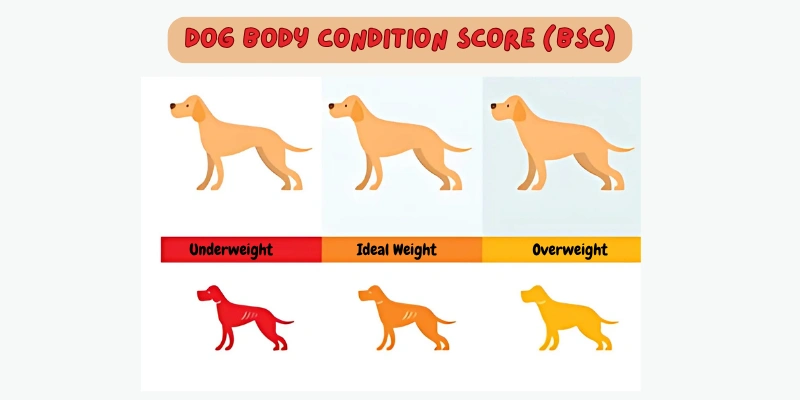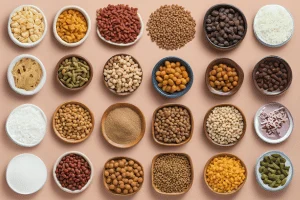Is My Dog Eating Enough? A Veterinarian’s Guide to Signs & Solutions
Published: 30 May 2025
Your dog’s calorie and nutrient needs aren’t static—they shift based on several factors:
- Age, breed, and size
- Activity level
- Reproductive status
- Health condition
- Individual metabolism
Feeding your dog isn’t just about quantity—it’s about balance. That means delivering the right mix of proteins, fats, carbohydrates, vitamins, and minerals tailored to your dog’s needs. The goal? Precise nutrition, not just “enough food.”
As a veterinarian with years of experience in canine nutrition, I’ve helped thousands of dog owners navigate these exact concerns. This expert-backed guide offers practical, science-based advice to help you confidently ensure your dog is getting exactly what they need—no more, no less.
Signs Your Dog Might Not Be Eating Enough
1. Low Body Condition Score (BCS)
Gently run your hands along your dog’s side. If the ribs, spine, and hip bones are clearly visible or easily felt without a fat covering, your dog may be underweight. A sharply defined waist and abdominal tuck, along with muscle loss, especially over the back and hindquarters, are also red flags.

2. Behavioural Indicators
Behavioural changes often signal nutritional gaps:
- Lethargy or low energy: Your dog seems tired, less playful, or unusually calm.
- Increased scavenging or begging: Constantly searching for food, eating non-food items, or begging excessively.
- Food obsession: Guarding food, eating too fast, or showing anxiety around mealtime.
- Mood changes: Irritability, anxiety, or lack of interest in surroundings.
3. Physical Changes Beyond Weight Loss
- Dull or thinning coat: A lack of essential fatty acids can reduce coat quality.
- Poor muscle mass: Noticeable muscle wasting, especially around the hips, spine, or shoulders.
- Weakened immune system: Frequent infections, slower healing.
- Changes in stool: Smaller, harder, or infrequent stools could indicate inadequate intake.
How Much Should You Really Be Feeding Your Dog?
Start with the Food Label
Use the guidelines on the food packaging as a starting point. But remember—these are averages. Every dog’s needs differ.
Understand Your Dog’s Calorie Needs
While the average adult, moderately active dog needs 25–30 calories per pound of body weight, the most accurate method involves formulas like:
- Resting Energy Requirement (RER)
- Maintenance Energy Requirement (MER)
Need help calculating? Try our interactive calorie calculator and feeding guide. It breaks down exact calorie needs by weight, age, and activity level. [Link to your tool]
Use a Food Scale, Not Measuring Cups
Measuring cups are often inaccurate. A digital kitchen scale ensures every meal is portioned correctly based on your dog’s calorie requirements.
Monitor, Evaluate, and Adjust
Track your dog’s weight and body condition score (BCS) regularly. Make gradual adjustments (5–10%) over a few days and reassess every 2–3 weeks. Watch for energy level, coat health, muscle tone, and stool quality.
For a detailed guide on a dog’s calorie needs, read our guide “How Many Calories Does a Dog Need?“
The Dangers of Underfeeding (Why It Matters)
Feeding too little can lead to serious long-term problems:
- Nutritional deficiencies: Poor growth, a weak immune system, and a dull coat.
- Muscle wasting and fatigue: Loss of strength and mobility.
- Organ dysfunction: Undernutrition can harm vital organs over time.
- Lower quality of life: Reduced energy, increased anxiety, and less engagement.
How to Ensure Your Dog Eats Enough
- Routine vet checkups: Get professional assessments of weight, BCS, and nutrition.
- Choose the right food: Opt for high-quality food that meets AAFCO standards for your dog’s life stage.
- Stick to a feeding schedule: Regular mealtimes promote digestion and appetite.
- Limit treats and table scraps: Treats should be no more than 10% of daily calories.
- Weigh your dog regularly: Track trends before they become problems.
- Keep a feeding log: Record meals, appetite changes, and stool patterns.
- Create a calm feeding space: Minimise noise and distractions to help your dog focus on eating.
Frequently Asked Questions (FAQs)
The easiest way is by performing a Body Condition Score (BCS) assessment. If you can easily see or feel prominent ribs, spine, or hip bones, and your dog has a severe waist tuck with no fat cover, they are likely too thin (BCS 1-3).
It is an urgent red flag. If your dog is consuming food but still losing weight, it strongly indicates an underlying medical issue preventing proper nutrient absorption or increasing metabolic demands. Contact your veterinarian immediately for a thorough examination and diagnostic tests.
An occasional skipped meal, especially if your dog is otherwise energetic and healthy, isn’t always a cause for alarm. However, if they consistently skip meals, go without food for over 24 hours, or show other symptoms like lethargy or vomiting, it warrants a veterinary check.
Highly active dogs (e.g., working dogs, competitive athletes) require significantly more calories than sedentary pets. Conversely, low-activity dogs need less food. Always adjust based on monitoring their Body Condition Score and energy levels. Our calorie calculator can help with precise adjustments.
You should primarily feed your dog based on their ideal body weight for their age and activity level. If currently underweight, aim for their healthy target weight and gradually increase food. If overweight, calculate their ideal weight to facilitate safe weight loss. Always make gradual adjustments and consult your vet.
While this guide provides extensive, expert-backed information, remember that every dog is an individual. If you have any concerns about your dog’s appetite, weight, or overall health, please consult your veterinarian. They are your best resource for personalised advice and medical care.

- Be Respectful
- Stay Relevant
- Stay Positive
- True Feedback
- Encourage Discussion
- Avoid Spamming
- No Fake News
- Don't Copy-Paste
- No Personal Attacks

- Be Respectful
- Stay Relevant
- Stay Positive
- True Feedback
- Encourage Discussion
- Avoid Spamming
- No Fake News
- Don't Copy-Paste
- No Personal Attacks





